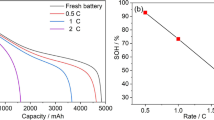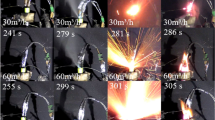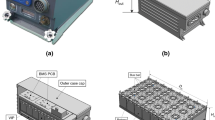Abstract
As an advanced energy storage medium, lithium-ion batteries (LIBs) are being used in aircraft and other aviation fields owing their unique advantages. The thermal runaway (TR) behaviours of LIBs used in aircraft are more complicated and dangerous due to the special operating environments, such as low pressure and enclosed environments. Therefore, a special test platform was designed to study the effect of low pressure on the TR characteristics of 2.2 Ah 18,650 type LIBs in this work. Some critical parameters of TR were obtained, such as onset temperature of TR, maximum temperature, voltage drop time, pressure, and the explosion limit of gases, etc. The results show that with the pressure increasing, the TR onset temperature, maximum temperature, and pressure increase in the test chamber, and the voltage drop time postpones. In addition, the amount of released gas and the explosion limitation range of gases increase with the decrease of the initial pressure. This means it’s easier to occur but with weaker hazard of TR at lower pressure. Besides, the SEM results reveal that deformation and structural damage of cathode materials, which is attributed to the increase of the large amount of gas released at the electrode material level. These results provide the basis for the safe application and storage of LIBs in a confined space under different pressures.










Similar content being viewed by others
References
Feng X, Ouyang M, Liu X, Lu L, Xia Y, He X (2018) Thermal runaway mechanism of lithium ion battery for electric vehicles: a review. Energy Storage Materials 10:246–267
Golubkov AW, Fuchs D, Wagner J, Wiltsche H, Stangl C, Fauler G, Voitic G, Thaler A, Hacker V (2014) Thermal-runaway experiments on consumer Li-ion batteries with metal-oxide and olivin-type cathodes. RSC Adv 4:3633–3642
Huang Z, Zhao C, Li H, Peng W, Zhang Z, Wang Q (2020) Experimental study on thermal runaway and its propagation in the large format lithium ion battery module with two electrical connection modes. Energy 205:117906
Wang Z, Yang H, Li Y, Wang G, Wang J (2019) Thermal runaway and fire behaviors of large-scale lithium ion batteries with different heating methods. J Hazard Mater 379:120730
Sanfelix J, Messagie M, Omar N, Van Mierlo J, Hennige V (2015) Environmental performance of advanced hybrid energy storage systems for electric vehicle applications. Appl Energy 137:925–930
Wang Q, Jiang L, Yu Y, Sun J (2019) Progress of enhancing the safety of lithium ion battery from the electrolyte aspect. Nano Energy 55:93–114
Henriksen M, Vaagsaether K, Lundberg J, Forseth S, Bjerketvedt D (2019) Explosion characteristics for Li-ion battery electrolytes at elevated temperatures. J Hazard Mater 371:1–7
Chen S, Wang Z, Wang J, Tong X, Yan W (2020) Lower explosion limit of the vented gases from Li-ion batteries thermal runaway in high temperature condition. J Loss Prev Process Ind 63:103992
Chen M, Liu J, Ouyang D, Wang J (2019) Experimental investigation on the effect of ambient pressure on thermal runaway and fire behaviors of lithium-ion batteries. Int J Energy Res 43:4898–4911
Chen M, Ouyang D, Weng J, Liu J, Wang J (2019) Environmental pressure effects on thermal runaway and fire behaviors of lithium-ion battery with different cathodes and state of charge. Process Saf Environ Prot 130:250–256
Hofmann A, Uhlmann N, Ziebert C, Wiegand O, Schmidt A, Hanemann T (2017) Preventing Li-ion cell explosion during thermal runaway with reduced pressure. Appl Therm Eng 124:539–544
Xie S, Ren L, Yang X, Wang H, Sun Q, Chen X, He Y (2020) Influence of cycling aging and ambient pressure on the thermal safety features of lithium-ion battery. J Power Sources 448:227425
Xie S, Sun J, Chen X, He Y (2020) Thermal runaway behavior of lithium-ion batteries in different charging states under low pressure. Int J Energy Res 45:5795–5805
Liu Y, Niu H, Li Z, Liu J, Xu C, Huang X (2021) Thermal runaway characteristics and failure criticality of massive ternary Li-ion battery piles in low-pressure storage and transport. Process Saf Environ Prot 155:486–497
Fu YY, Lu S, Shi L, Cheng XD, Zhang HP (2018) Ignition and combustion characteristics of lithium ion batteries under low atmospheric pressure. Energy 161:38–45
Wang H, Du Z, Liu L, Zhang Z, Hao J, Wang Q, Wang S (2020) Study on the thermal runaway and its propagation of lithium-ion batteries under low pressure. Fire Technol 56:2427–2440
Feng B, Zhai Y, Zhang L (2021) Toward the mechanism study of Pd/gamma-Al2O3-assisted bioalcohol combustion in a flow reactor. Energy Fuels 35:14954–14962
Liu X, Ren D, Hsu H, Feng X, Xu G-L, Zhuang M, Gao H, Lu L, Han X, Chu Z, Li J, He X, Amine K, Ouyang M (2018) Thermal runaway of lithium-ion batteries without internal short circuit. Joule 2:2047–2064
Wang Q, Ping P, Zhao X, Chu G, Sun J, Chen C (2012) Thermal runaway caused fire and explosion of lithium ion battery. J Power Sources 208:210–224
Feng X, Zheng S, Ren D, He X, Wang L, Cui H, Liu X, Jin C, Zhang F, Xu C, Hsu H, Gao S, Chen T, Li Y, Wang T, Wang H, Li M, Ouyang M (2019) Investigating the thermal runaway mechanisms of lithium-ion batteries based on thermal analysis database. Appl Energy 246:53–64
Lei B, Zhao W, Ziebert C, Uhlmann N, Rohde M, Seifert H (2017) Experimental analysis of thermal runaway in 18650 cylindrical Li-ion cells using an accelerating rate calorimeter. Batteries 3:14
Finegan DP, Darcy E, Keyser M, Tjaden B, Heenan TMM, Jervis R, Bailey JJ, Vo NT, Magdysyuk OV, Drakopoulos M, Michiel MD, Rack A, Hinds G, Brett DJL, Shearing PR (2018) Identifying the cause of rupture of Li-ion batteries during thermal runaway. Adv Sci (Weinh) 5:1700369
Koch S, Fill A, Birke KP (2018) Comprehensive gas analysis on large scale automotive lithium-ion cells in thermal runaway. J Power Sources 398:106–112
Larsson F, Bertilsson S, Furlani M, Albinsson I, Mellander B-E (2018) Gas explosions and thermal runaways during external heating abuse of commercial lithium-ion graphite-LiCoO2 cells at different levels of ageing. J Power Sources 373:220–231
Golubkov AW, Scheikl S, Planteu R, Voitic G, Wiltsche H, Stangl C, Fauler G, Thaler A, Hacker V (2015) Thermal runaway of commercial 18650 Li-ion batteries with LFP and NCA cathodes—impact of state of charge and overcharge. Rsc Adv 5:57171–57186
Kong WH, Li H, Huang XJ, Chen LQ (2005) Gas evolution behaviors for several cathode materials in lithium-ion batteries. J Power Sources 142:285–291
Browning KL, Baggetto L, Unocic RR, Dudney NJ, Veith GM (2013) Gas evolution from cathode materials: a pathway to solvent decomposition concomitant to SEI formation. J Power Sources 239:341–346
Spotnitz R, Franklin J (2003) Abuse behavior of high-power, lithium-ion cells. J Power Sources 113:81–100
Diaz F, Wang Y, Weyhe R, Friedrich B (2019) Gas generation measurement and evaluation during mechanical processing and thermal treatment of spent Li-ion batteries. Waste Manag 84:102–111
Mathieu O, Grégoire CM, Turner MA, Mohr DJ, Alturaifi SA, Thomas JC, Petersen EL (2022) Experimental investigation of the combustion properties of an average thermal runaway gas mixture from li-ion batteries. Energy Fuels 36:3247–3258
Said AO, Lee C, Stoliarov SI (2020) Experimental investigation of cascading failure in 18650 lithium ion cell arrays: impact of cathode chemistry. J Power Sources 446:227347
Baird AR, Archibald EJ, Marr KC, Ezekoye OA (2020) Explosion hazards from lithium-ion battery vent gas. J Power Sources 446:227257
Mendiburu AZ, Coronado CR, de Carvalho JA (2020) Difficulties on the determination of the flammability limits of fuel mixtures by the Law of Le Chatelier. Process Saf Environ Prot 142:45–55
Li W, Wang H, Zhang Y, Ouyang M (2019) Flammability characteristics of the battery vent gas: a case of NCA and LFP lithium-ion batteries during external heating abuse. J Energy Storage 24:100775
Acknowledgements
This work is supported by the National Natural Science Foundation of China (Grant No. U2033204), the University Synergy Innovation Program of Anhui Province (Grant No. GXXT-2020-079), and the Fundamental Research Funds for the Central Universities (Grant No. WK2320000051). Q. Wang is supported by Youth Innovation Promotion Association CAS (Grant No.Y201768).
Author information
Authors and Affiliations
Corresponding author
Additional information
Publisher's Note
Springer Nature remains neutral with regard to jurisdictional claims in published maps and institutional affiliations.
Electronic supplementary material
Rights and permissions
About this article
Cite this article
Li, Y., Jiang, L., Huang, Z. et al. Pressure Effect on the Thermal Runaway Behaviors of Lithium-Ion Battery in Confined Space. Fire Technol 59, 1137–1155 (2023). https://doi.org/10.1007/s10694-022-01296-1
Received:
Accepted:
Published:
Issue Date:
DOI: https://doi.org/10.1007/s10694-022-01296-1




